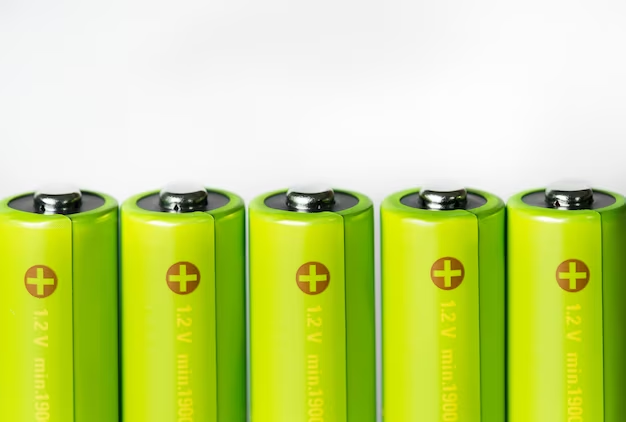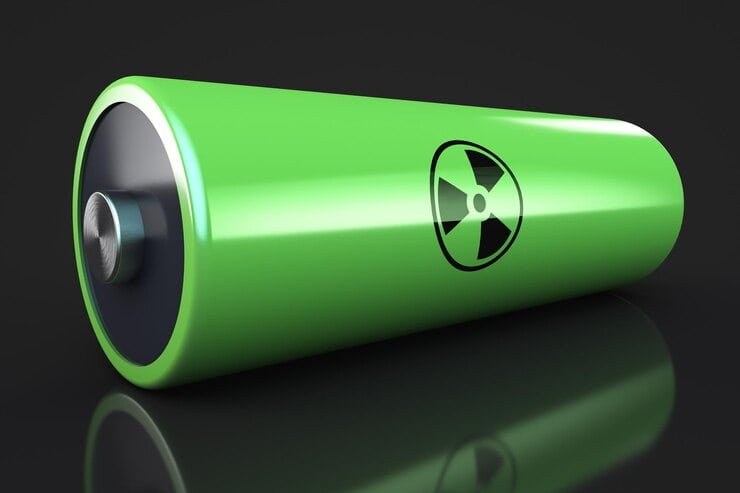Table of Contents
Alternative of Lithium Ion Batteries

Nuclear battery
A recent/ Latest development in the energy sector has seen US firms introduce nuclear batteries with an impressive 50-year lifespan as a strategic move to counter China’s advances in technology and energy infrastructure. The plan is made. These nuclear batteries, also known as micro reactors or advanced small modular reactors (SMRs), represent a significant leap forward in the search for long-term, reliable and sustainable energy sources.

In addition to their strategic and environmental advantages, nuclear batteries offer a promising alternative to conventional lithium-ion batteries. Although lithium batteries are widely used in a variety of applications, they have limitations, including short life, the need for frequent recharging, and dependence on a supply chain that is often geographically sensitive. Nuclear batteries, with their extended 50-year lifespan and ability to provide continuous power without the need for recharging, offer a viable solution for long-term energy needs, particularly in remote or high-demand scenarios. Where reliability and durability are most important. The technology could reduce reliance on lithium, helping to address concerns about resource depletion and environmental impacts associated with lithium mining and battery disposal.
What is a Nuclear battery?
Nuclear batteries are compact, self-contained energy systems that use nuclear reactions to generate electricity. Unlike conventional nuclear reactors, which are large and require extensive infrastructure, nuclear batteries are much smaller, more portable, and easily deployed. They are intended as a power source for remote locations, military bases, space missions, and even communities that are off the power grid.
A nuclear battery, also known as a radioisotope thermoelectric generator (RTG) or atomic battery, is a device that generates electricity from the radioactive decay of isotopes. It converts heat released from nuclear reactions into electrical power without the need for combustion, making it a highly reliable and durable energy source.
Nuclear batteries can function continuously for decades, offering power where traditional batteries or energy sources might fail. They have been widely used in space missions, remote sensing equipment, and some military applications.
How Does a Nuclear Battery Work?
Nuclear batteries harness the energy produced by the radioactive decay of isotopes. Here’s how it works:
- Radioactive Decay: A radioactive material, often plutonium-238, undergoes a natural process of decay, releasing heat.
- Heat to Electricity Conversion: The heat generated is captured by thermocouples, devices that convert temperature differences into electrical energy through the Seebeck effect.
- Continuous Power Output: This process provides a continuous flow of electricity, typically at low power levels, but for a much longer period compared to conventional batteries.
The core advantage of nuclear batteries is their ability to produce energy steadily over decades without external refueling or maintenance.
Applications of Nuclear Batteries
Nuclear batteries are ideal for situations where long-term, maintenance-free power is crucial. Some key applications include:
- Space Exploration: NASA and other space agencies have relied on nuclear batteries for missions like the Voyager, Curiosity Rover, and New Horizons. These batteries provide power to spacecraft operating in distant, sunless regions of space where solar power is not viable.
- Medical Devices: In the medical field, nuclear batteries are used in devices like pacemakers and other implants that require long-term, reliable power without frequent battery replacement surgeries.
- Remote Sensing and Monitoring: Nuclear batteries are useful in remote or harsh environments such as the Arctic, deep-sea, or desert regions, powering sensors and communication devices where regular battery replacement is impractical.
- Military and Defense: Military applications, including unmanned drones, remote surveillance systems, and other field equipment, benefit from nuclear batteries due to their longevity and reliability.
Advantages of Nuclear Batteries
Nuclear batteries offer several distinct advantages over traditional energy sources:
- Longevity: Nuclear batteries can last anywhere from 10 to 50 years, depending on the isotope used. This longevity makes them suitable for applications requiring low-maintenance, long-term power solutions.
- Reliability: Unlike conventional batteries that degrade over time, nuclear batteries can continuously provide power in extreme environmental conditions, such as deep space, underwater, or arctic climates.
- Compact and Lightweight: For the energy output they provide, nuclear batteries are relatively compact, making them suitable for small devices or space-limited applications like spacecraft or medical implants.
- No Moving Parts: Since nuclear batteries operate based on radioactive decay and heat conversion, they don’t have any moving parts. This makes them more durable and less prone to mechanical failure.
- Sustainability: In terms of fuel efficiency, nuclear batteries use small amounts of isotopes, which can provide significant energy output over time. While not a renewable energy source, their long lifespan and minimal fuel usage make them an efficient solution for specific needs.
The Future of Nuclear Batteries
As the demand for long-lasting, sustainable energy sources grows, nuclear batteries hold significant potential for the future. Researchers are exploring ways to enhance their efficiency, reduce costs, and make them more versatile for various applications.
One area of research is the development of betavoltaic batteries, which use beta radiation from isotopes like tritium to generate electricity. These batteries could be used in everyday devices such as smartphones, wearable technology, and sensors. Their ability to last decades without recharging offers promising advancements in portable electronics and low-power applications.
Another future possibility is the use of nuclear fusion to create small, scalable power sources that could provide even greater energy output than current nuclear batteries.
50 Year Life of Alternative of Lithium Ion Batteries
One of the most prominent features of these nuclear batteries is their longevity. With a designed lifespan of up to 50 years, these batteries can provide continuous power without the need for frequent refueling or maintenance. This long operational life makes them highly attractive for use in scenarios where consistent power is important, but where access to conventional energy sources or infrastructure is limited.
Strategic Implications for the United States
The development of nuclear batteries is part of a broader strategy by American firms and government agencies to maintain technological leadership and energy independence in the face of growing competition from China. China is investing heavily in advanced nuclear technologies, including its small modular reactors, and is seeking to become a world leader in the field.
By advancing nuclear battery technology, the US aims to counter China’s influence and ensure it remains at the forefront of energy innovation. These batteries can also play an important role in supporting US military operations, particularly in remote or hostile environments where reliable energy sources are essential.
Environmental and economic benefits of Alternative of Lithium Ion Batteries
In addition to their strategic importance, nuclear batteries offer several environmental and economic benefits:
- Low Carbon Emissions: Nuclear batteries produce zero carbon emissions during operation, making them a clean energy alternative to fossil fuels.
- Energy Security: With a lifespan of 50 years, these batteries provide a stable and secure energy source that is less vulnerable to supply chain disruptions or geopolitical tensions.
- Cost-Effective: Over their operational lifetime, nuclear batteries can be more cost-effective than other energy sources, especially in remote or high-demand scenarios where fuel transportation or infrastructure construction is needed. The cost is prohibitive.
Challenges and Considerations
Despite their potential, the deployment of nuclear batteries is not without challenges. Public perception and regulatory hurdles are important, as the word “nuclear” often evokes concerns about safety, waste disposal, and potential environmental impacts. Additionally, the initial cost of developing and deploying these systems can be high, although this can be offset by long-term savings and strategic benefits.
Despite their numerous advantages, nuclear batteries also face some challenges:
- Radioactive Material: Nuclear batteries contain radioactive isotopes, which pose risks related to radiation exposure and contamination. However, most modern nuclear batteries are designed with multiple layers of shielding to contain radiation safely.
- Cost: The production of nuclear batteries, especially those using isotopes like plutonium-238, can be costly. The availability of these isotopes is also limited, making them a more expensive option compared to traditional batteries or solar power.
- Power Output: Nuclear batteries typically produce low amounts of power, which limits their use to applications where low-energy, long-duration power is needed. They are not suitable for high-energy applications like powering cities or electric vehicles.
- Public Perception: The use of nuclear materials often raises concerns about safety, even though nuclear batteries are designed to be safe and pose minimal risk under normal operating conditions.
Frequently Asked Questions (FAQ) About Nuclear Batteries
1. What is a nuclear battery?
A nuclear battery, also known as a radioisotope thermoelectric generator (RTG) or atomic battery, is a device that generates electricity from the radioactive decay of isotopes. It converts heat from nuclear reactions into electrical power, offering long-term, continuous energy for decades without the need for external refueling.
2. How do nuclear batteries work?
Nuclear batteries work by using a radioactive isotope, such as plutonium-238, which releases heat as it decays. This heat is then converted into electricity using thermocouples, which take advantage of the temperature difference to produce electrical power. The process is efficient, reliable, and requires no moving parts.
3. What are the advantages of nuclear batteries?
Nuclear batteries offer several key advantages:
- Long lifespan: They can operate continuously for decades without maintenance.
- Reliability: They work in extreme environments, such as deep space or underwater, where other power sources might fail.
- Compact size: These batteries are small and lightweight compared to their energy output.
- No moving parts: This makes them less prone to mechanical failures and increases their durability.
4. What are the applications of nuclear batteries?
Nuclear batteries are used in a variety of fields, including:
- Space exploration: Powering spacecraft like NASA’s Voyager, Curiosity Rover, and New Horizons, where solar power is insufficient.
- Medical devices: Providing long-lasting energy for pacemakers and other implants.
- Remote sensing: Powering sensors and equipment in harsh or inaccessible environments, such as polar regions or deep oceans.
- Military uses: Supporting unmanned vehicles, remote surveillance systems, and other long-term, low-maintenance applications.
5. Are nuclear batteries safe?
Yes, nuclear batteries are designed with multiple layers of shielding to safely contain radioactive materials. While they do use isotopes that emit radiation, modern designs minimize the risk of exposure. These batteries have been used safely in space missions and medical devices for decades.
6. How long do nuclear batteries last?
Depending on the isotope used and the application, nuclear batteries can last anywhere from 10 to 50 years. The longevity depends on the half-life of the radioactive material and the battery’s design.
7. What materials are used in nuclear batteries?
The most common material used in nuclear batteries is plutonium-238, which has a half-life of 87.7 years. Other isotopes like tritium and strontium-90 are sometimes used, particularly in betavoltaic batteries.
8. Can nuclear batteries be used in consumer electronics?
At present, nuclear batteries are not commonly used in consumer electronics due to their high cost and low power output. However, researchers are exploring betavoltaic batteries, which could potentially power devices like smartphones and sensors in the future.
9. Are nuclear batteries expensive?
Yes, the production of nuclear batteries can be expensive due to the cost of radioactive materials like plutonium-238 and the specialized equipment needed for handling and manufacturing. However, their long-term operation and low maintenance make them cost-effective in certain applications, such as space exploration or medical devices.
10. What is the difference between nuclear batteries and conventional batteries?
The primary difference is that nuclear batteries generate electricity through radioactive decay, whereas conventional batteries rely on chemical reactions. Nuclear batteries offer longer lifespans, often lasting decades, while conventional batteries need frequent recharging or replacement.
11. What is a betavoltaic battery?
A betavoltaic battery is a type of nuclear battery that uses beta particles emitted during radioactive decay to generate electricity. Betavoltaic batteries typically use isotopes like tritium and are being developed for low-power applications like wearable electronics, sensors, and medical devices.
12. Are nuclear batteries environmentally friendly?
Nuclear batteries are not renewable, but they are highly efficient and generate very little waste compared to other energy sources. Since they operate for decades without refueling, they reduce the need for frequent battery replacements and minimize environmental impact in long-term applications.
13. Can nuclear batteries explode?
No, nuclear batteries do not have the potential to explode. They don’t use combustion or traditional nuclear fission processes, so there is no risk of a meltdown or explosion. The radioactive materials are contained and shielded to prevent exposure.
14. Why are nuclear batteries used in space exploration?
Nuclear batteries are ideal for space exploration because they can provide continuous, reliable power in environments where solar power is insufficient, such as deep space or shadowed areas of planets and moons. They have been crucial in missions like Voyager and Curiosity Rover, enabling them to operate for decades.
15. What is the future of nuclear batteries?
The future of nuclear batteries looks promising, with ongoing research into improving their efficiency and finding new applications. Betavoltaic batteries are being developed for consumer electronics, and there is potential for nuclear fusion technology to create small, portable nuclear power sources. As demand for long-lasting, sustainable energy grows, nuclear batteries could become more widely adopted.
16. Are nuclear batteries the same as nuclear reactors?
No, nuclear batteries and nuclear reactors are different. Nuclear batteries generate electricity from radioactive decay, producing small amounts of power for long periods. In contrast, nuclear reactors use controlled nuclear fission to generate large amounts of energy, typically for electricity grids or industrial applications.
17. Can nuclear batteries be recycled?
Recycling nuclear batteries is challenging due to the radioactive materials they contain. However, there are efforts to safely manage and dispose of spent nuclear batteries. Some components, such as the thermoelectric materials, may be recycled, but the radioactive isotopes require special handling.
18. How small can nuclear batteries be?
Nuclear batteries can be made quite small, even down to the size of a grain of rice. These micro-scale nuclear batteries, such as betavoltaic cells, are being explored for applications like medical implants and small sensors, where long-term power is required in a tiny form factor.
19. What are the main challenges with nuclear batteries?
The main challenges with nuclear batteries include:
- High cost: Due to the rarity of isotopes like plutonium-238.
- Limited power output: They are generally suitable for low-power applications.
- Radioactive materials: Handling and disposal of radioactive waste must be done carefully to avoid environmental and health risks.
20. Can nuclear batteries replace traditional energy sources?
While nuclear batteries offer many advantages, they are not suitable for replacing traditional energy sources like fossil fuels or solar power on a large scale. Their low power output and high cost make them ideal for niche applications requiring long-term, reliable energy rather than large-scale electricity generation.
Conclusion
US firms’ plans to develop nuclear batteries with a 50-year lifespan represent a bold step in the energy sector, with important implications for national security, technological leadership, and environmental sustainability. As these technologies advance, they will play an important role in shaping the future of energy and positioning the United States as a leader in the global energy landscape, countering the rise of China and other competitors in this critical field. can pay

